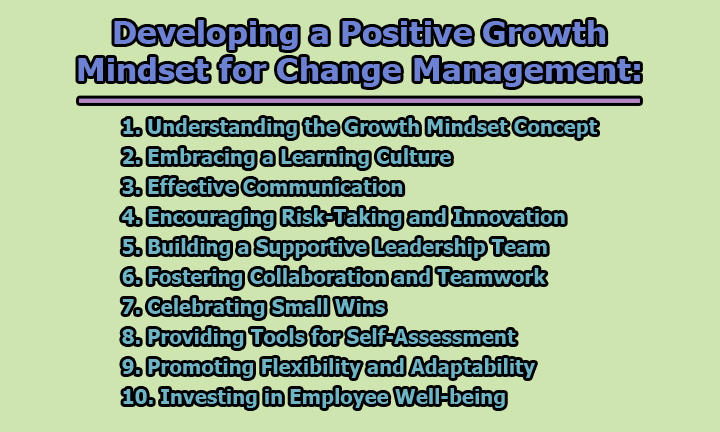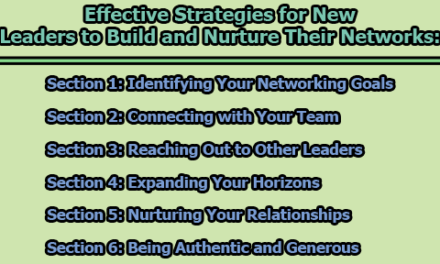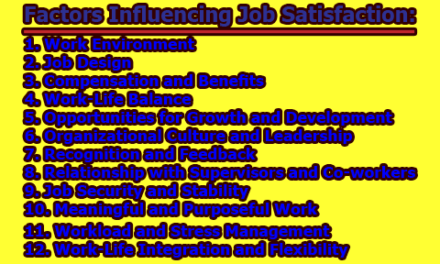Developing a Positive Growth Mindset for Change Management:
In today’s dynamic and ever-evolving business landscape, change is not just inevitable; it’s a constant. Organizations that thrive are those that can adapt, innovate, and embrace change with a positive mindset. Developing a growth mindset is crucial for successful change management, as it empowers individuals and teams to view challenges as opportunities for learning and improvement. In this article, we will explore the following statement, “Developing a positive growth mindset for change management”.
1. Understanding the Growth Mindset Concept: To initiate the journey of change management, it is imperative to comprehend the concept of a growth mindset. Coined by psychologist Carol Dweck, a growth mindset posits that abilities and intelligence can be developed through dedication and hard work (Dweck, 2006). This stands in contrast to a fixed mindset, where individuals perceive their traits as innate and unalterable. Fostering a growth mindset in the context of change management involves instilling the belief that challenges present opportunities for learning and improvement.
Understanding Dweck’s research is fundamental, as it underscores the impact of mindset on behavior and success. Dweck’s seminal work reveals that individuals with a growth mindset are more inclined to embrace challenges, persevere in the face of setbacks, and view effort as a pathway to mastery (Dweck, 2008). Consequently, organizations aiming for successful change management must cultivate a culture that encourages the belief in the potential for development and improvement at both individual and collective levels.
2. Embracing a Learning Culture: Organizations prioritizing a learning culture are better positioned to navigate change effectively. A learning culture fosters an environment where employees are encouraged to continually acquire new skills and knowledge. This involves providing access to resources, training programs, and mentorship opportunities (Senge, 1990). In such an environment, change is perceived as an avenue for personal and professional growth rather than a disruptive force.
Research by the Society for Human Resource Management (SHRM) underscores the significance of a learning culture in enhancing employee engagement and organizational performance (SHRM, 2019). By embracing a growth mindset within a learning culture, employees become more adaptable, open to new ideas, and better equipped to contribute meaningfully during times of change.
3. Effective Communication: Clear and transparent communication is pivotal in change management, playing a crucial role in shaping employees’ perceptions and responses. Leaders must communicate the reasons behind the change, its anticipated benefits, and its alignment with broader organizational goals (Kotter, 1996). This openness establishes trust and helps employees understand the rationale behind the change initiative, thereby reducing resistance and fear.
According to a study published in the Journal of Organizational Change Management, effective communication is positively correlated with successful change implementation (Armenakis & Harris, 2009). When employees feel informed and involved, they are more likely to embrace change and contribute constructively to the transformation process. Therefore, investing in communication strategies is an integral aspect of fostering a growth mindset during change management.
4. Encouraging Risk-Taking and Innovation: A growth mindset thrives in an environment that encourages risk-taking and innovation. Employees should be empowered to experiment, share ideas, and even embrace failure as a stepping stone toward improvement (Amabile & Pratt, 2016). Research in the Journal of Applied Behavioral Science highlights the positive correlation between a culture of innovation and organizational success (Scott & Bruce, 1994). When employees are encouraged to take risks, they become more resilient, creative, and adaptable – essential qualities for navigating change.
Leaders play a pivotal role in fostering a culture of innovation. By acknowledging and rewarding calculated risks, leaders set the tone for the entire organization, reinforcing the idea that innovation and growth go hand in hand. This approach not only enhances problem-solving capabilities but also instills a positive mindset that views challenges as opportunities.
5. Building a Supportive Leadership Team: Leadership sets the tone for organizational culture, making it imperative for leaders to embody a growth mindset. Leaders should actively seek feedback, acknowledge their own mistakes, and demonstrate a commitment to continuous improvement (Covey, 1989). This authenticity inspires trust and encourages employees to adopt a similar mindset, creating a culture where growth is celebrated.
Research published in the Harvard Business Review emphasizes the role of leadership in shaping organizational culture during change (Cameron & Green, 2015). Leaders who exhibit a growth mindset contribute to a positive and adaptive culture that embraces change as a necessary part of growth. When leadership actively engages in self-improvement and demonstrates resilience in the face of challenges, it establishes a powerful example for the entire organization to follow.
6. Fostering Collaboration and Teamwork: Change management is inherently a collective effort that requires collaboration. Cultivating a culture of teamwork, where individuals feel supported and can leverage each other’s strengths, is crucial. Teamwork not only enhances problem-solving but also creates a sense of shared responsibility for the success of the change initiative (Cameron & Green, 2015). Collaborative efforts contribute to a positive atmosphere, where the collective intelligence of the team becomes a driving force for innovation and adaptability.
Research in organizational behavior underscores the positive impact of teamwork on employee engagement and organizational performance (Katzenbach & Smith, 1993). By fostering collaboration, organizations encourage a growth mindset, as employees recognize that their collective efforts contribute to the overall success of the organization.
7. Celebrating Small Wins: Acknowledging and celebrating small victories play a pivotal role in maintaining momentum during change. Recognizing incremental progress through positive reinforcement motivates employees and reinforces the belief that effort leads to success (Amabile & Pratt, 2016). This approach creates a positive feedback loop, where small wins contribute to a sense of accomplishment, fostering a growth mindset across the organization.
According to research in organizational psychology, celebrating achievements, no matter how small, enhances employee morale and commitment (Locke & Latham, 2002). By actively recognizing and rewarding accomplishments during change, organizations reinforce the idea that continuous improvement and success are achievable through sustained effort.
8. Providing Tools for Self-Assessment: Equipping employees with tools for self-assessment and reflection is crucial for fostering a growth mindset. Encouraging individuals to set personal and professional development goals promotes a sense of ownership over their growth (Senge, 1990). Regular self-assessment emphasizes the importance of continuous improvement, aligning with the principles of a growth mindset.
Research in organizational development highlights the positive impact of self-assessment on employee performance and satisfaction (London & Smither, 2002). By providing employees with the means to reflect on their progress and set goals for improvement, organizations empower individuals to take an active role in their development, contributing to the overall cultivation of a growth mindset.
9. Promoting Flexibility and Adaptability: A growth mindset aligns seamlessly with flexibility and adaptability. Cultivating an organizational culture that values agility and embraces change as a constant is crucial (Cameron & Green, 2015). Proactively promoting flexibility prepares employees for the uncertainties that come with change, making them more resilient and open to new opportunities.
Research in organizational behavior emphasizes the importance of adaptability in the face of change (O’Reilly & Tushman, 2004). Organizations that actively promote a mindset of adaptability and flexibility create an environment where employees are more willing to embrace change as a natural and necessary part of the organizational journey.
10. Investing in Employee Well-being: Change can be emotionally challenging, making employee well-being a paramount consideration. Providing support systems, counseling services, and initiatives that prioritize mental health is essential (Cameron & Green, 2015). A workforce that feels valued and supported is more likely to approach change with a positive mindset, reducing stress and enhancing overall productivity.
Research in organizational psychology highlights the significant impact of employee well-being on job satisfaction and performance (Wright & Cropanzano, 2000). By investing in initiatives that prioritize mental health and well-being, organizations not only demonstrate a commitment to their employees’ welfare but also create a foundation for a positive and resilient mindset during times of change.
In conclusion, developing a positive growth mindset is not just a strategy for navigating change but a fundamental aspect of organizational success. By fostering a culture that values learning, collaboration, and adaptability, businesses can empower their workforce to embrace change as an opportunity for growth and improvement. The ten points outlined in this article serve as practical guidelines for cultivating a growth mindset within the context of change management, ultimately contributing to the long-term resilience and success of the organization.
References:
- Amabile, T. M., & Pratt, M. G. (2016). The Dynamic Componential Model of Creativity and Innovation in Organizations: Making Progress, Making Meaning. Research in Organizational Behavior, 36, 157-183.
- Armenakis, A. A., & Harris, S. G. (2009). Reflections: Our Journey in Organizational Change Research and Practice. Journal of Organizational Change Management, 22(6), 586-596.
- Cameron, E., & Green, M. (2015). Making Sense of Change Management: A Complete Guide to the Models, Tools & Techniques of Organizational Change. Kogan Page.
- Covey, S. R. (1989). The 7 Habits of Highly Effective People. Simon & Schuster.
- Dweck, C. S. (2006). Mindset: The New Psychology of Success. Random House.
- Dweck, C. S. (2008). Mindset: The New Psychology of Success. New York: Ballantine Books.
- Katzenbach, J. R., & Smith, D. K. (1993). The Wisdom of Teams: Creating the High-Performance Organization. Harvard Business Review Press.
- Kotter, J. P. (1996). Leading Change. Harvard Business Review Press.
- Locke, E. A., & Latham, G. P. (2002). Building a practically useful theory of goal setting and task motivation: A 35-year odyssey. American Psychologist, 57(9), 705-717.
- London, M., & Smither, J. W. (2002). Feedback orientation, feedback culture, and the longitudinal performance management process. Human Resource Management Review, 12(1), 81-100.
- O’Reilly, C. A., & Tushman, M. L. (2004). The ambidextrous organization. Harvard Business Review, 82(4), 74-83.
- Scott, S. G., & Bruce, R. A. (1994). Determinants of Innovative Behavior: A Path Model of Individual Innovation in the Workplace. Academy of Management Journal, 37(3), 580-607.
- Senge, P. M. (1990). The Fifth Discipline: The Art and Practice of the Learning Organization. Doubleday.
- Society for Human Resource Management (SHRM). (2019). “The High Cost of a Toxic Workplace Culture.”
- Wright, T. A., & Cropanzano, R. (2000). Psychological well-being and job satisfaction as predictors of job performance. Journal of Occupational Health Psychology, 5(1), 84-94.

Assistant Teacher at Zinzira Pir Mohammad Pilot School and College










